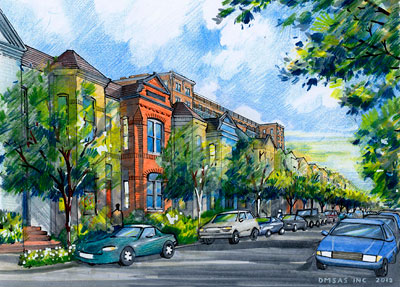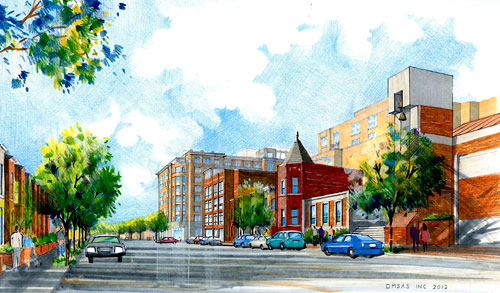Board lauds 13th and U design, still balks at height
The Historic Preservation Review Board lavished praise on the architectural design for a proposed residential building at 13th and U Streets, NW, but demurred from approving the project yesterday, as they could not make themselves entirely comfortable with the building’s size.
The 8-story building would replace the one-story Rite Aid-anchored strip mall at the corner of 13th and U. JBG, the property’s owner, wants to build a distinctive residential building in a classic style that evokes many of the large buildings on streets like Connecticut Avenue.
JBG had originally proposed a hotel for the corner, but changed it to residences based on neighborhood pushback against a hotel. They also made the building slightly shorter and set back the top 2 floors. They also stepped the building down in the rear, toward the Wallach Place row houses across the alley to the south.
Based on these changes, ANC 1B approved the design, and Historic Preservation Office staff also were satisfied with the design, after working extensively with the architect. Preservation officer Steve Callcott explained at yesterday’s hearing that since the U Street historic district was created, there has been debate over whether tall buildings belong on U Street at all, given the shorter row houses.
Ultimately, he said, most preservation staff and board members concluded that taller buildings did belong. After all, there are 100-year-old buildings of such heights near row houses in many other parts of the city today.
We don’t tend to think of [the tall buildings] as incompatible with the row houses. We think of them as simply a different building type that relates very well and creates a dynamic urban environment, and I think our feeling is that this proposal would do the same thing. It’s without a doubt larger than the buildings around it. It’s unabashedly an apartment building. But the way the design has been detailed and organized and articulated, despite the disparity in scale and height, it could be a very appropriate neighbor and addition to the U Street historic district.
Some residents of Wallach Place, however, continued to argue that the building should lose one or two more floors. The site is not very deep, and there are smaller row houses immediately across. Since the building is to the north, it won’t actually affect the light on their yards, but they objected to the scale of this building compared to others nearby.
Most preservation board members, while they roundly complimented architect David Schwarz on the design, verbally struggled with their decisions but ultimately couldn’t agree with the building’s size. Architect Graham Davidson, who frequently suggests removing one more floor from buildings that come before him, continued this pattern, but with trepidation.
The building would be a lot better if it were a story lower. The reason I’m conflicted about this is that there are other buildings in the neighborhood which are as high as this building, and have been approved, and have been built, and they’re not nearly as good. And it pains me to have to consider penalizing this building, which has been designed so carefully and will be a much more successful building, and to require that it be reduced in size when there are other buildings that are this height and aren’t as succcessful.
Davidson also talked about how the overall proportions of the building were so elegant that any reduction would disrupt the overall look of the building. Likewise, just cutting it down on 13th Street, which is the most residential end, would make it unbalanced and asymmetric.
Nancy Metzger noted that the Ellington, a building of similar height, has greater setbacks. Where it borders townhouses, HPRB forced it to have a smaller end piece. But here, Davidson noted, it’s difficult to make one end look like a separate building. (Personally, that end piece has always looked awkward to me, like we almost built a whole building but not quite.)
Metzger seemed to feel she needed to support residents in asking the architect to remove more from the building, but couldn’t figure out what. “It is a very elegant building,” she said, “And it is very hard as I’ve been sitting here to say, okay, what is out of it? And I guess I would come down to the point where I think maybe a story needs to come off maybe because it is so big.”
Bob Sonderman, the archaeologist member on the board, said,
I just feel like the little country boy from Capitol Hill. We’re just not used to big buildings,and this is a really big building. I am fully in support of the architectural design. It’s fantastic, it’s gorgeous, the proportions are wonderful. It’s just a really attractive building, and I think the U Street corridor should be pleased to have an architect of this quality to design a building in this corridor.
It’s a huge improvement over many other buildings that this board, and me, have approved in the past. I’m loathe to suggest a reduction in height, but I think that would help a bit. The 13th st facade is great, I love the curves and the corners, but that is a long facade of work there. It’s big; but it’s pretty… big.
Andrew Aurbach, on the other hand, raised a question of whether it was appropriate for the board to be trying to decide the overall size. “Maybe these are more zoning concerns than they are preservation concerns,” he said, referring to a frequent statement by board members that they only consider what’s historic and don’t get into zoning matters. Aurbach suggested finding a way to adjust the 13th Street end to reduce the impression of height without actually shrinking the building.
Newly-elected board chair Gretchen Pfaehler also wasn’t disturbed by the overall density, but wanted some significant changes. She suggested the architect add more of a “reveal” which conceals some of the mass and girth of the building from some angles.
The traditional style of the building draws upon the critical details, the proportions, the window openings [of precedent in the area]. it’s a beautiful building. I think that to me it’s a matter of the height along the edge which gets into scaling and massing.
I would push to go just a little bit farther in terms of reveal and pulling away, not only from the pedestrian perception. One thing that makes the Ellington, the Mayflower, the hotel on 14th and K that we just landmarked, even though very large buildings, do have this reveal.
I would propose to my colleagues on the board that I don’t think it’s an issue of the height as much the proximity of the height along the length of the street. I’m comfortable with the height and I wouldn’t direct the applicants to remove a story, but there needs to be more variation in the proximity of the heights to the street. That would give you relief but allow you to have the density that you need.
Pfaehler also acknowledged how the board has to balance “preservation” concerns with the needs of a growing city, especially in this rapidly changing neighborhood.
It’s not just the preservation of the heritage that’s there, but there needs to be viable infill that provides the affordable vitality that these communities need in order to keep them moving & living. Otherwise we have a museum set, and that’s not what DC is about.
Pfaehler proposed a resolution to give the applicant the direction she had outlined, which passed unanimously. It’s not entirely clear, but that seems to mean that they don’t have to take off any floors, but should look for ways to give the 13th Street end some architectural features which break up its height a bit and let the view people see evolve as they approach on 13th Street from the south.
Ultimately, this case highlighted very starkly the different pressures within preservation for large-scale new construction. How much of it is about a good architectural design that respects the historic context? How much is HPRB just another hurdle which forces projects to shrink down a little more from what they already had in negotiating with the ANC? How much do board members want to actually be making zoning decisions even though they supposedly aren’t?
Here, we had a building which the neighborhood generally approved of, the preservation office supported, and for which board members had nothing but the highest praise for the design. Yet 4 members still felt an irresistable pressure to make the building smaller.
Pfaehler might have turned them away from that course for now, and perhaps the architect can accommodate their concerns in a way that doesn’t disrupt the opportunity to create a building that future residents will cherish as a highlight of the neighborhood rather than another chimeric compromise.





